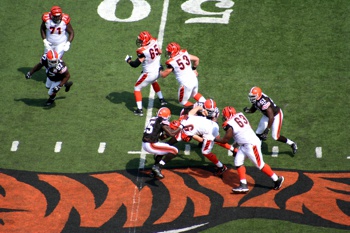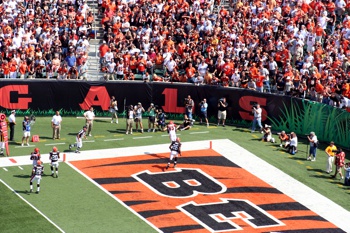
Shout It Out Design / Shutterstock.com
Based in Cincinnati, Ohio, the Cincinnati Bengals play in the NFL’s American Football Conference (AFC) North. Their home matches are played at the Paul Brown Stadium which is located in downtown Cincinnati and their main rivals are the Baltimore Ravens, Cleveland Browns, and the Pittsburgh Steelers.
The name of the Cincinnati Bengals comes originally from an earlier American football team, which played from 1937 – 1941. It was in 1967 that the formation of the modern version of the Cincinnati Bengals began to take place when leading coach, Paul Brown, led an ownership group who were granted a franchise in the American Football league who later merged with the National Football League (NFL).
The Cincinnati Bengals have appeared in the playoffs every year since 2011 but to date they remain one of the thirteen current NFL teams never to have won a Super Bowl, losing both their appearances in 1981 and 1988.
Fast Facts
- Full Name: Cincinnati Bengals
- Conference: American Football Conference
- Division: North
- Location: Cincinnati
- Stadium Name: Paul Brown Stadium
- Year Established: 1968
- Owner: Stephen Mike Brown
- Head Coach: Marvin Lewis
- Manager: Mike Brown
- Nickname: The Bungles (in 1990s due to poor form)
- Mascot: Who Dey
- Team Colours: Black, orange and white
History

Shout It Out Design / Shutterstock.com
Although there was a Cincinnati Bengals team back in 1937 – 1941 playing American football, the modern incarnation of the team dates back to 1967 when leading American football coach, Paul Brown, and a group of backers were awarded a franchise into the American Football League. Merging almost immediately with the NFL, the early days of the Bengals were reasonably successful winning the American Football Conference (AFC) Central Division Championship in 1970 and 1973 and reaching the playoffs in those years, as well as in 1975.
The 1980s brought even greater honours, including two appearances at the Super Bowl. Appearing at the 1981 season’s Super Bowl XVI, they were unfortunately beaten by the San Francisco 49ers 26-21. The 1988 appearance was their next (and last) appearance at Super Bowl XXIII where they played the San Francisco 49ers once again, and were again defeated 20-16.
The 1990 season brought hope that the new decade would be a successful one and they once again reached the playoffs after winning the AFC Central Championship. Beating the then Houston Oilers in the Wild Card Playoffs by 41-14, they were then defeated by the then Los Angeles Raiders 20-10. Unfortunately, this was the last season that saw any sort of form for some years and the 1990s and the early 2000s were a period of great struggle for the Bengals, as they didn’t make the playoffs for 15 years. It was a time of turmoil for the team and they went through several team managers and confidence in Mike Brown, who owned the Bengals, plummeted.
However, since the mid 2000s and the appointment of Marvin Lewis as head coach, the Cincinnati Bengals form has increased considerably. The appointment of several top players, including Andy Dalton as quarterback has also helped, as has strong and consistent management and leadership from the top. The Bengals remain one of only 13 current teams never to have won a Super Bowl but with appearances in the playoffs every year in the past five, it surely will only be a matter of time before they win their first.
Super Bowl Appearances
1988 Super Bowl XXIII Cincinnati Bengals 16 – San Francisco 49ers 20
The second appearance at a Super Bowl for Cincinnati saw them once again play the San Francisco 49ers. Unfortunately, they were once again on the losing side. Played at the Joe Robbie Stadium in Miami, Florida on January 22, 1989, the game is perhaps best remembered for the 49ers fourth quarter winning drive. The 49ers eventually ran out 20-16 winners but many of those who watched the game believe it was a close call, as the Bengals pushed the 49ers to their limit and could have easily gone on to win it if luck had been on their side.
1981 Super Bowl XVI San Francisco 49ers 26 – Cincinnati Bengals 21
Played at the Pontiac Silverdome in Michigan on January 24, 1982, Super Bowl XVI saw the Cincinnati Bengals take on the San Francisco 49ers. The first ever Super Bowl to be held in a cold weather city, the snow may have caused several logistical issues around the stadium but had no effect on the game inside which was fast, exciting and dynamic. One of the most watched broadcasts in American history, over 85 million viewers saw the Bengals lose to the 49ers 26-21. Cris Collinsworth and Dan Ross were the standout players for the Bengals, becoming only the second pair of teammates ever to each have 100 receiving yards at a Super Bowl.
Stadium

Paul Brown Stadium (photo.ua / Shutterstock.com)
Historically, the Cincinnati Bengals shared the Riverfront Stadium/Cinergy Field with the Major League Baseball’s Cincinnati Reds. This was until both teams started to complain that this facility started to look shabby and lacked the modern amenities. This led to the Paul Brown Stadium being built on the site for the Bengals and the Great American Ball Park for the Reds. The Paul Brown Stadium is also the administrative headquarters for the Bengals.
Playing at the Paul Brown stadium since 2000, there were many complaints about the state of the pitch in the early years with the natural Kentucky Bluegrass being difficult to maintain. This led to the stadium being fitted with the FieldTurf system – an artificial alternative that looks and feels just like the real thing. As well as being an excellent surface to play on, it enables the Bengals to save over $100,000 per year on maintenance.
Thanks to this tough surface it means that a wide variety of sports and events can be played at the stadium, which currently has a capacity of over 65,000. As well as a variety of high school and college games, the Macy’s Music Festival is held there every year, as is the annual Queen City Classic Chess Tournament. There have also been various music gigs held in the stadium – the first being Kenny Chesney and Tim McGraw’s Brothers of the Sun tour in 2012.
Famous Players
Ken Anderson
Widely considered the best #14 ever to play the game, Ken Anderson finished his career with 32,838 passing yards and an 81.9 career QBR. He never managed to win a Super Bowl with the Bengals but he was a seasoned campaigner and led the Bengals in their fantastic 1981 season where he was crowned league MVP.
Ken Riley
With a total of 65 interceptions in his career, it’s no wonder that Ken Riley is still a favourite with many Bengals fans. Playing over 200 games for the Bengals he, like Ken Anderson, was an integral part of their successful 1981 season.
Anthony Munoz
Considered almost universally as the best Bengal of all time, Anthony Munoz anchored the offensive line for 13 years, the brightest period of the Bengals’ history. One of seven Bengals to play in both of their Super Bowl appearances, he is still a popular figure to this day.
Boomer Esiason
Although he spent time at the New York Jets and the Arizona Cardinals during his career, the ten years he spent at the Cincinnati Bengals are widely considered to be best of his career. A four-time Pro Bowler, he is thought by many to be the best ever left handed quarterback in NFL history. He finished his career the most successful left handed quarterback in history with 37,920 passing yards and 247 touchdown passes
Did You Know?
- The Cincinnati Bengals and the Cleveland Browns, both based in Ohio, were both founded by Paul Brown, long-time NFL coach and owner.
- The Cincinnati Bengals’ signature striped helmets first made their appearance in 1981.
- When the Paul Brown Stadium was built, over 8,000 trees and shrubs were planted in the surrounding area.
- The Bengals are well known for their supporters chant: “Who dey, who dey, who dey think gonna beat dem Bengals?” The answer screamed all together is, of course, “Nobody!”
- Thanks to the above chant, the team’s mascot is known as ‘Who Dey’.
